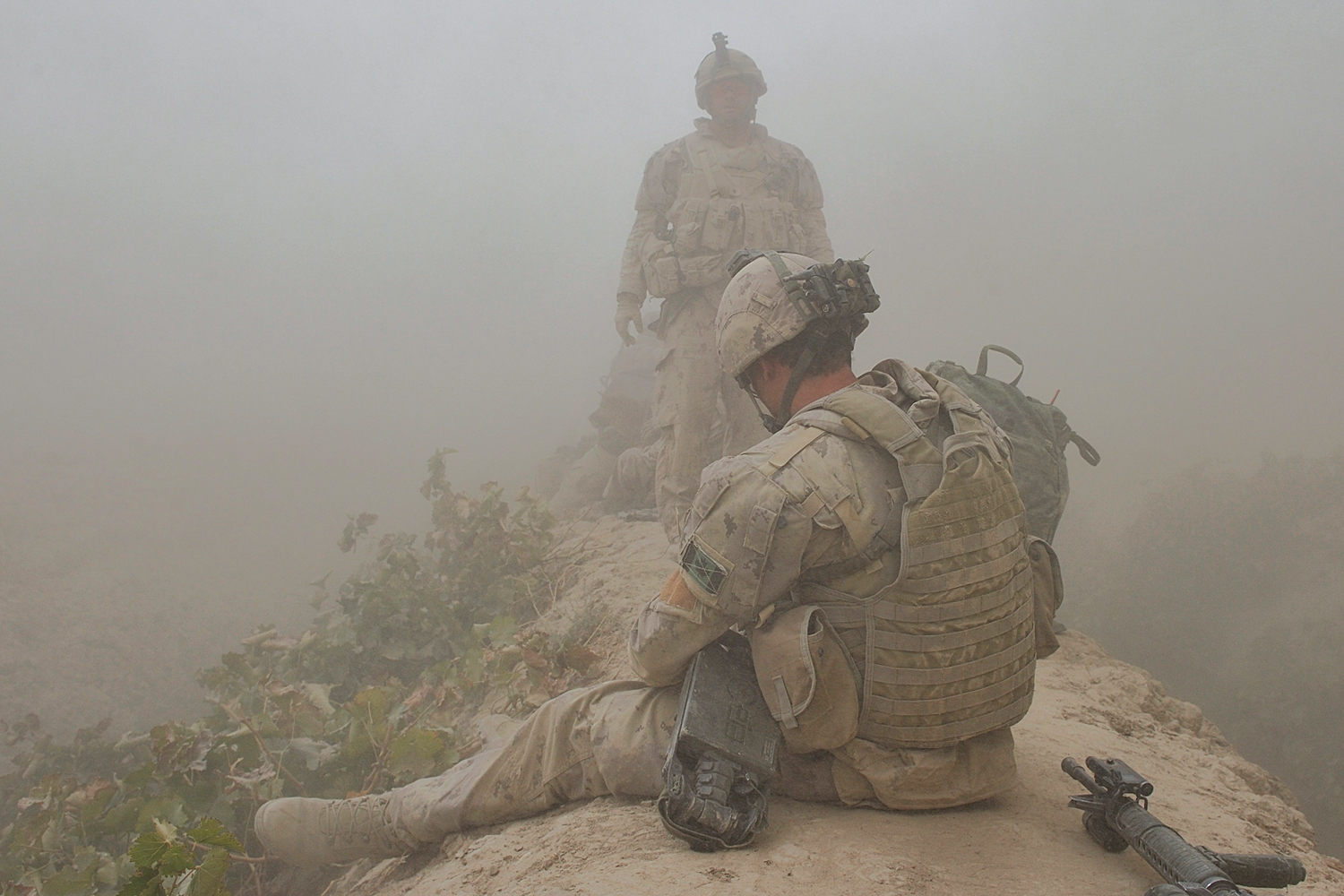After reports of respiratory illness following live firing training, the Norwegian Defence Research Establishment discovered a less obvious danger than pistols and rifles. Their researchers measured lung function of 55 healthy soldiers, then had them fire rifles using different kinds of ammunition. Tests afterwards showed a five per cent decline in lung function an hour later, and a seven per cent decline over 24 hours, regardless of ammunition used.
Now the researchers are looking at how to avoid this occupational hazard, including air filters and new ammunition design.

Members of the Royal Canadian Regiment battle group wait for smoke to clear after a cratering charge was detonated in Panjwaii district. [Sgt. Daren Kraus/Task Force Kandahar]
Military lungs are the subject of much recent concern as defence departments around the world struggle to minimize the occupational health hazards of very risky jobs. Often it’s a game of catch-up.
An ounce of prevention, they say, is worth a pound of cure, but it’s an adage often forgotten in the rush to the battlefields. In times of cuts to military budgets, pennies for prevention are often sacrificed for bucks for bullets, as happened in the Canadian Armed Forces in the early 1990s, just before 5,100 Canadian personnel deployed for the Persian Gulf War.
It was “the most toxic battlefield ever known to mankind,” retired nurse Louise Richard told the House of Commons Standing Committee on Veterans Affairs in 2013. Like many of her comrades, she went to war healthy and super fit, and returned permanently sick. She reported quarters and work areas were drenched in pesticides. The air was fouled by toxic smoke from 800 oil wells burning in Kuwait and military base burn pits, which disposed of plastics, unexploded ordnance, batteries, medicine, dead animals and human and medical waste. Close to a million shells were fired, many containing depleted uranium.
The U.S. Department of Defense estimates each
of its large deployment bases burns 30,000 to
40,000 kilograms of waste a day.
“As invariably happens when preventive health efforts are neglected, a series of health concerns arose,” in 1990s deployments, wrote Lieutenant-Colonel Jean-Robert Bernier (later CAF’s surgeon general) in a 2003 report, Threats to Operational Force Health Protection. Investigations resulted in four reports, dozens of recommendations and eventual improvements to occupational health monitoring.
Now Deployable Health Hazard Assessment Teams test the air, water and soil for chemical, biological and radiological health hazards before and during Canadian deployments.
An assessment at air bases in Kuwait where Canadians supply air support for Joint Task Force Iraq, showed soil and water quality did not exceed health guidelines, but air quality varied from good to unhealthy. The report, in a kiosk presentation at the 2015 Canadian Military and Veterans Health Forum, concluded that due to short tours and day-to-day variability, “one would not expect continued, chronic or delayed onset of illness” among those deployed.
A report on 11 years of air quality assessments during Canada’s mission to Afghanistan concluded sand and particulates could cause eye, nose and throat irritation and respiratory symptoms. But “there is currently little scientific evidence to support clinically significant delayed-onset or long-term health effects” from sporadic exposure, through research is limited and ongoing, said another forum kiosk presentation by a team of national defence researchers. Both these reports are based on samples from the air, not veterans’ health tests, it should be noted.
Veterans across the continent await a study for the U.S. Congress based on 65,000 reports from veterans of the Afghanistan and Iraq wars who now have respiratory problems after exposure to smoke from burn pits, pollutants and toxic dust on deployment.
The U.S. Department of Defense estimates each of its large deployment bases burns 30,000 to 40,000 kilograms of waste a day. That’s a lot of smoke. One researcher doubts the 47 per cent increase in U.S. veterans’ respiratory problems is due to smoke inhalation, because not all troops were exposed to it. But everyone was exposed to mineralized dust, produced by the burn pits or from detonation of weapons that fused metal dust to microscopic debris. But some, perhaps wishful thinkers, say it just occurs naturally.
Dust samples contained 147 different bacteria and fungi and microparticles of copper, iron and titanium, which form crystals in the lungs. Titanium and iron are also linked to pulmonary fibrosis and pulmonary hypertension.
The health hazards associated with burn pit smoke was flagged as a concern in 2006. Five years later, the U.S. Defense Department asked the Institute of Medicine to investigate, but it replied there wasn’t enough evidence to positively identify the culprit, whether the smoke or particulate matter in dust, or some other factor.
Tens of thousands of U.S. troops reported disabling lung problems after deployment; CT scans and non-invasive tests showed nothing, but damage showed up in lung biopsies. A study of 7,000 U.S. troops deployed between 2004 and 2010 showed respiratory illness is seven times more likely in Iraq and Afghanistan veterans.
Preventive measures could not only have saved the cost of treatment, but psychological costs to troops substantiating their claims, and damage to trust and morale.
In military health matters, an ounce of prevention saves way more than a pound of cure.
Advertisement





















